- Home
- Fire Safety
- Your Ultimate Guide to Fire Alarm Panel Safety & Regulations
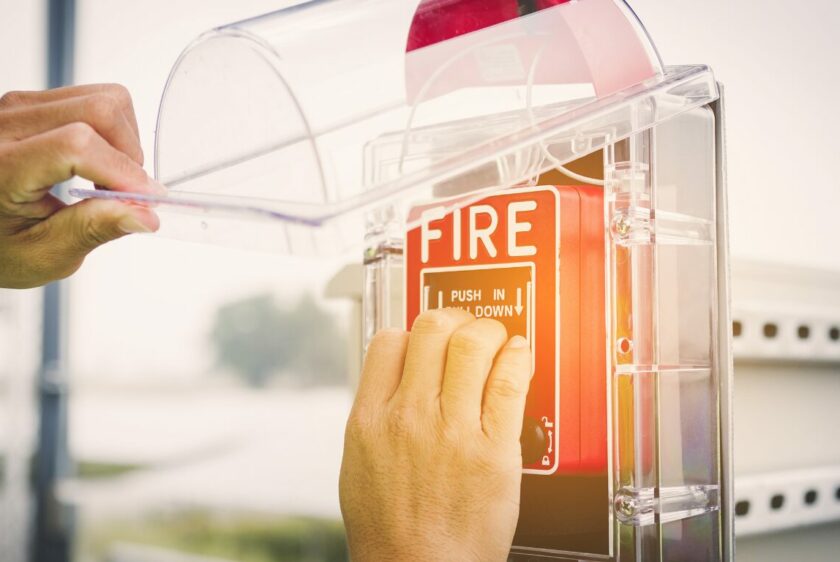
Your Ultimate Guide to Fire Alarm Panel Safety & Regulations
In the United Kingdom, fire alarm panels are a critical component of a building’s fire safety system. This means as a business owner or property owner, it’s important you understand the standards, strategic placement, and maintenance for maximising fire safety. This ultimate guide provides an in-depth look at the principles and best practices for managing fire alarm panels in the UK, ensuring compliance with regulations and enhancing the protection of lives and property.
Key Takeaways
- Adherence to UK fire safety principles, such as maximising non-combustibility (Principle D) and anticipating arson attempts (Principle E), is crucial for effective fire alarm panel implementation.
- Strategic placement of fire alarm panels, guided by essential placement recommendations and integration with fire escape routes and suppression systems, is vital for prompt detection and response.
- Advanced fire alarm technologies, including various system types and innovations that reduce fire severity (Principle I) and resist fire ingress (Principle L), enhance overall fire safety.
- Regular maintenance and compliance with UK fire regulations, including Electrical Installation Condition Reports (EICR), uphold safety commitments (Principle Y) and ensure accountability (Principle V).
- Best practices for fire alarm panel management involve procuring quality materials (Principle T) and extending structural stability (Principle H), minimising damage and ensuring reliable performance.
Understanding UK Fire Alarm Panel Standards
The Importance of Principle D: Maximising Non-Combustibility
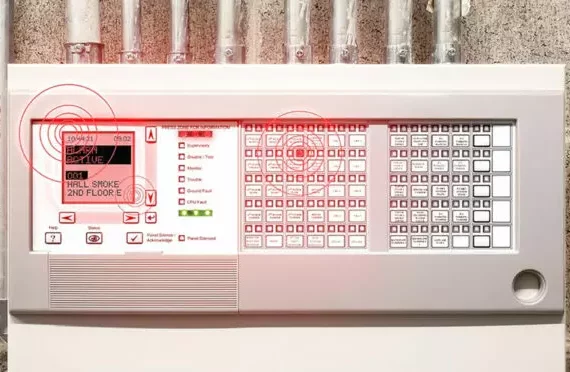
In our pursuit of fire safety excellence, we must prioritise the maximisation of non-combustibility in all materials used within fire alarm systems. The essence of Principle D is to ensure that, as far as reasonably practicable, all components are non-combustible, meeting the stringent classifications of class A1 or class A2-s1, d0 as per BS EN 13501-1:2018 standards.
To adhere to this principle, we advocate for the selection of materials that inherently resist ignition and limit the potential for fire spread. This approach not only enhances the overall safety of the building but also aligns with the broader objectives of fire safety management, including the containment of fires within designated compartments.
By implementing non-combustible materials, we contribute to the creation of fire resistant barriers that are crucial for the integrity of fire compartments. These barriers are designed to withstand fire, smoke, and heat for a predetermined duration, effectively delaying the spread of fire and providing occupants with valuable time to evacuate.
The following list outlines the key recommendations to maximise non-combustibility:
- Select materials that meet or exceed the A1 or A2-s1, d0 classification.
- Ensure that fire alarm panels and associated components are composed of non-combustible materials.
- Adopt higher fire resistance requirements to enhance compartmentation and structural stability.
- Design out or control cavities within compartment walls and floors to prevent the spread of flames and smoke.
By embracing these practices, we not only comply with Principle D but also fortify our commitment to safeguarding lives and properties from the devastating effects of fire.
Adhering to Principle E: Anticipating Arson Attempts
We understand the gravity of arson, a criminal act that is the leading cause of fire in the UK, accounting for over half of all fires attended by fire and rescue services annually. To mitigate this risk, it is crucial to anticipate arson attempts and implement preventative measures, particularly at lower storeys where the threat is most prevalent.
By adhering to Principle E, we introduce measures to prevent, as far as reasonably practicable, an anticipated arson attack from an external fire source. This could involve objects thrown or positioned to cause damage within or around the building.
The Essential Principles guidance goes beyond the minimum fire resistance requirements of Approved Document B, advocating for enhanced compartmentation. This strategy aims for a complete burnout of a compartment’s contents, with the understanding that fire and rescue services must intervene to confirm extinguishment before considering the fire event over. The following list outlines key steps to adhere to Principle E:
- Conduct a thorough risk assessment focusing on arson vulnerability.
- Install surveillance systems to deter potential arsonists.
- Use fire-resistant materials in construction to minimise the spread of fire.
- Ensure that external areas are well-lit and free from combustible materials.
- Train staff in arson prevention and fire safety protocols.
Implementing Principle F: Monitoring Building Services
We understand the critical role that monitoring building services plays in fire safety. It is our responsibility to ensure that all building services, including renewable energy sources and mains utility connections, are designed and installed to mitigate fire risks. Regular inspections and maintenance are not just recommended; they are a necessity to prevent these systems from becoming a source of fire or contributing to its spread.
By adhering to Principle F, we actively reduce the risk of fire by maintaining a vigilant oversight over building services. This includes the use of non-combustible insulation on installations such as ductwork or pipework, which can significantly lower the fire load.
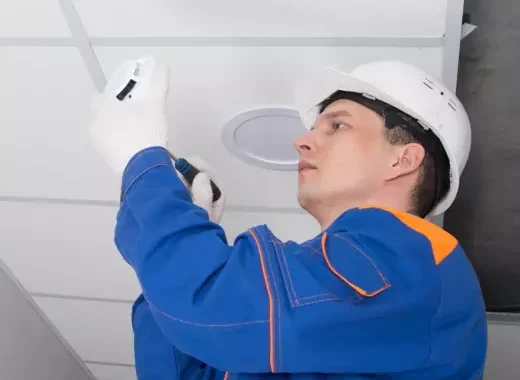
To achieve this, we must engage contractors who operate under third-party quality work schemes and adhere to manufacturer requirements. The information below outlines the key components of a Building Management System (BMS) and the recommended frequency of their maintenance:
BMS Components:
- Power Supply Units.
- Signal Receiving Equipment.
- Detectors and Manual Call Points.
- Other Detection and Suppression Systems.
Maintenance Frequency:
- Bi-annual maintenance for your power supply units.
- Annual maintenance for your signal receiving equipment .
- Quarterly maintenance for your detectors and manual call points.
- As per manufacturer’s guidelines for any other detection and suppression systems.
In conclusion, we must prioritise regular maintenance to optimise the effectiveness and lifespan of our fire alarm systems. Addressing minor issues promptly through routine checks can prevent larger problems, ensuring the safety and comfort of building occupants.
Strategic Placement and Installation of Fire Alarm Panels
Essential Placement Guide for Maximum Effectiveness
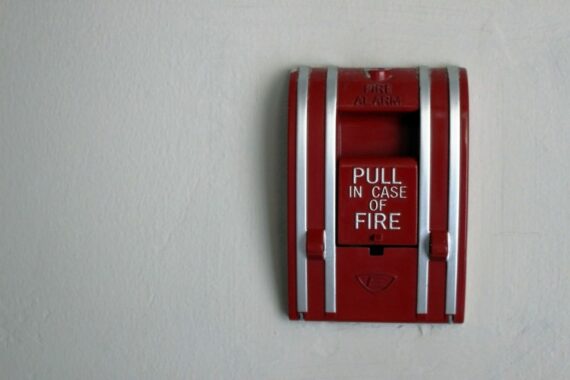
In our pursuit of fire safety excellence, we recognise the critical role that the strategic placement of fire alarm panels plays. Proper positioning is paramount to ensure swift detection and response in the event of a fire. To this end, we have identified several key locations that are essential for the installation of fire alarm panels:
- Entry and exit points, to facilitate immediate alerts and prompt evacuation.
- High-risk areas such as kitchens and boiler rooms, where the likelihood of a fire starting is greater.
- Sleeping quarters and hallways, to ensure that occupants are quickly alerted, even during periods of rest.
- Central locations on each floor to provide adequate coverage and ensure the alarm is audible throughout.
It is crucial to avoid placing fire alarm panels in isolated areas where they may not be heard or in environments with extreme temperatures that could affect their operation.
Furthermore, we must consider the integration of fire alarm systems with other safety measures. This includes aligning them with fire escape routes and suppression systems to create a cohesive safety strategy. By adhering to these guidelines, we can significantly enhance the effectiveness of our fire safety protocols and ensure a higher level of protection for all occupants.
The Role of Fire Alarm Systems in London’s Safety Regulations
In Glasgow, the integration of fire alarm systems that adhere to fire safety regulations is not just a matter of compliance; it is a commitment to the protection of lives and property. The stringent safety regulations in the UK mandate the use of advanced fire alarm systems to ensure rapid detection and response in the event of a fire.
Fire alarm systems are a critical component in any comprehensive approach to fire safety. Their role extends beyond mere detection, encompassing the management of evacuation procedures and the activation of fire suppression systems.
To align with the UK’s safety regulations, it is essential to consider the following points:
- The selection of appropriate fire alarm systems tailored to the specific needs of a building.
- Regular risk assessments to ensure the fire alarm system’s effectiveness for all occupants, including those with disabilities.
- Adherence to the Electrical Installation Condition Report (EICR) requirements, which assess the safety and functionality of electrical installations.
By diligently following these guidelines, we can contribute to a safer environment for your Glasgow property.
Integrating Fire Alarm Systems with Fire Escape Routes and Suppression Systems
In our pursuit of safety, we recognise the critical role that the integration of fire alarm systems with fire escape routes and suppression systems plays. Ensuring a seamless connection between these elements is crucial for the effective evacuation and suppression of fires, particularly in open plan designs.
To achieve this, we must consider the aesthetic integration without compromising safety. Innovative solutions, such as concealing fire curtains or designing custom sprinkler covers, allow us to maintain the desired look while ensuring robust fire safety.
The goal is to strike a balance between the open, airy feel of the space and the uncompromised functionality of fire safety systems.
Here is a concise list of critical considerations for integrating these systems:
- Escape routes.
- Location of fire-separating elements and fire doorsets.
- Locations of fire detection devices, alarm controls, and safety signage.
- Sprinkler systems and smoke control systems.
- Areas of high risk and specifications of fire safety equipment.
- Maintenance schedules and management of fire safety arrangements.
- Provisions for the evacuation of disabled people.
Sprinkler systems, which activate in response to heat, are especially crucial in kitchens and other high-risk areas. The challenge lies in incorporating these systems in a way that is both functional and aesthetically pleasing. Loft conversions and staircase modifications often require alternative escape routes or fire-resistant materials, underscoring the importance of thoughtful design in fire safety planning.
Enhancing Fire Safety Through Advanced Alarm Technologies
The Different Types of Fire Alarm Systems and Their Applications
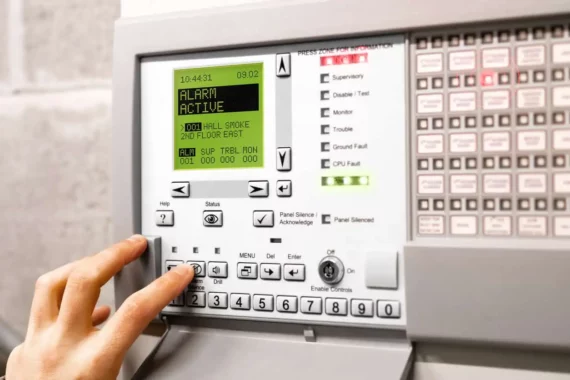
In our quest to enhance fire safety, we must first understand the various types of fire alarm systems and their specific applications. The three primary categories are Analogue, Addressable, and Conventional Fire Alarm Systems. Each type offers unique features and is suited to different environments and requirements.
- Analogue Fire Alarm Systems are known for their high levels of sophistication and intelligence. They are capable of pinpointing the exact location of a fire, making them ideal for large and complex buildings.
- Addressable Fire Alarm Systems allow each device on the system to be individually identified. This precision ensures a swift response to the exact area of danger, which is crucial in densely populated structures.
- Conventional Fire Alarm Systems are simpler and more cost-effective. They are typically used in smaller premises where a less complex system is sufficient.
It is important that we select the appropriate fire alarm system to match the specific needs of a building. This ensures not only compliance with safety regulations but also maximises the protection of lives and property.
Understanding the nuances of each system allows us to tailor our approach to fire safety. For instance, in the UK we have a tightly regulated environment, the choice of a fire alarm system must align with stringent safety regulations to ensure the utmost protection.
Incorporating Principle I: Reducing Fire Severity with Technology
We understand the critical role that technology plays in mitigating the severity of fires. By incorporating advanced fire detection and suppression technologies, we aim to significantly reduce the potential damage caused by fire incidents. The integration of smart fire alarm systems is essential in providing early detection and prompt response, which are crucial in minimising fire impact.
- Smart smoke detectors that differentiate between types of smoke.
- Heat sensors that activate at specific temperature thresholds.
- Automated suppression systems that deploy in the event of a fire.
These technologies not only enhance safety but also contribute to the management of false fire alarms, which can be triggered by a variety of factors, from technical malfunctions to malicious hoaxes. By tackling these issues, we not only protect people and structures but also ensure that emergency services are not diverted from real emergencies.
It is our commitment to stay abreast of the latest advancements in fire alarm technologies to ensure the highest level of safety for all occupants. By doing so, we uphold our responsibility to reduce fire severity and the associated risks.
In line with Principle I, our approach to fire safety is comprehensive, addressing susceptibility, vulnerability, and recoverability. This holistic strategy ensures that our buildings are not only less likely to experience a fire but are also better equipped to contain and recover from one should it occur.
Principle L: Resisting Fire Ingress with Effective Alarm Systems
We understand the crucial role fire alarm systems play in resisting fire ingress and ensuring the safety of occupants within a building. By adhering to Principle L, we aim to enhance the compartmentation of buildings, which is a vital aspect of fire safety design. Enhanced compartmentation allows for the containment of fire within a designated area, preventing it from spreading and causing further damage.
The adoption of higher fire resistance requirements than those laid out in Approved Document B is crucial. It ensures that the fire alarm systems provide ample time for evacuation and intervention by the fire and rescue service.
Incorporating advanced technologies into our fire alarm systems is not just about detecting fire; it’s about creating a robust barrier against fire spread. Residential services, for example, now include home monitoring systems with remote monitoring for added security. These systems are designed to provide a quick response to alarms, police notification, and can even contribute to potential insurance premium reductions.
Here is a summary of the essential principles that guide our approach to fire safety and alarm systems:
- Principle D: Maximise non-combustibility
- Principle E: Anticipate arson attempts
- Principle F: Monitor building services
- Principle H: Extend structural stability
- Principle I: Reduce fire severity
- Principle J: Control compartment cavities
- Principle L: Resist fire ingress
- Principle N: Minimise consequential damage
- Principle T: Procure quality materials
- Principle U: Require competent work
- Principle V: Verify recorded information
- Principle Y: Keep maintenance commitments
Fire Alarm Panel Maintenance and Compliance
Principle Y: Upholding Maintenance Commitments for Safety

We understand the gravity of maintaining our fire alarm panels to ensure the ongoing safety of our buildings. Regular inspections, testing, and maintenance are not just recommended practices; they are legal requirements under relevant British Standards such as BS 5839. These standards provide comprehensive guidelines for the design, installation, commissioning, and maintenance of fire detection and alarm systems.
To uphold our maintenance commitments, we must:
- Inspect regularly and test the systems to confirm their functionality.
- Promptly maintain or replace any part of the fire alarm system when required.
- Employ specialist operatives who are trained and supervised under third-party certified schemes.
It is imperative that our inspection and maintenance works ensure the continued effectiveness of the fire alarm system throughout the life of the building.
Furthermore, we allocate the necessary resources for performing routine maintenance activities on time and without interruptions. This includes having skilled technicians who are familiar with the operations and can efficiently carry out the required tasks. Developing detailed documentation is also crucial, outlining the procedures for each maintenance task along with any relevant safety guidelines or troubleshooting tips.
Ensuring Compliance with UK Fire Regulations and EICR Requirements
In our commitment to uphold the highest standards of fire safety, we must ensure strict adherence to UK fire regulations and the Electrical Installation Condition Report (EICR) requirements. The EICR is a critical document that assesses the safety and reliability of a property’s electrical installations, identifying any defects or potential hazards that could contribute to fire risks.
To maintain compliance, it is imperative that all fire alarm systems and related building services are designed, installed, commissioned, and maintained to prevent fire ignition or spread. This includes the strategic use of non-combustible insulation on installations such as ductwork or pipework.
It is also essential to engage competent professionals for the installation and maintenance of fire safety measures. These specialists should be trained and supervised under third-party quality of work schemes accredited by UKAS. Here is a list of steps to ensure compliance:
- Confirm that protection measures are installed by accredited specialists.
- Maintain a full disclosure of fire safety information.
- Regularly test electrical systems to detect any potential dangers.
- Adhere to manufacturer requirements and UK fire safety regulations.
By following these guidelines, we can provide assurance that our fire alarm systems meet the necessary performance levels and contribute to the overall safety of the premises.
Principle V: Verifying Recorded Information for Accountability
We understand the critical importance of verifying recorded information for accountability in fire safety management. Protection measures must be installed by specialists who are not only trained but also supervised under stringent third-party accreditation schemes. This ensures that the recorded information at handover is both pertinent and accurate, allowing us to insist that contractors satisfy their statutory and contractual duties.
It is essential that the recorded information provides full disclosure of the premises as built and commissioned, which is vital for effective facilities management.
The audits we conduct are completed to a high standard, systematically and in line with our policies. By making relevant information from these audits available to our operational teams and control room operators, we ensure that risk is managed effectively. However, we must remain vigilant in maintaining consistency, especially in how evacuation plans are recorded. To this end, we have provided our staff with additional guidance and continue to improve our quality assurance processes.
Maintenance and Regular Testing:
- Ensure ongoing safety through consistent maintenance and regular testing.
- Verify that risk assessments are accurately recorded and communicated to all relevant parties.
- Continuously review and enhance quality assurance processes to uphold the highest standards of fire safety.
Best Practices for Fire Alarm Panel Management
Principle H: Extending Structural Stability Through Alarm Systems
We understand the critical role that fire alarm systems play in maintaining the structural integrity of a building during a fire. As per principle H, our focus is on preventing partial structural collapse, thereby ensuring that the building can withstand the imposed loads of both non-fire and fire situations for an extended period. This goes beyond the statutory life safety requirements and addresses the risk of accidental disproportionate collapse.
To achieve this, we consider the building as a whole entity, including the structure of compartments and the primary roof structure. It’s essential to minimise movements by limiting deflections in expected non-fire situations and to define tolerances through iterations of a movements and tolerances report. Moreover, we aim to protect the building from consequential damage, facilitate simple repairs, and plan for salvage operations.
By adhering to principle H, we not only safeguard the occupants but also extend the life of the building, ensuring that it remains a safe and secure environment for all users.
Our commitment to principle H is reflected in our partnership with RACAM, who offers cutting-edge fire alarm systems in Glasgow. These systems provide early warning and integration capabilities, ensuring compliance and
certification for reliable protection and tailored solutions for businesses.
Principle N: Minimising Consequential Damage with Prompt Detection
We understand the critical role that prompt detection plays in minimising consequential damage in the event of a fire. Early detection is paramount to limiting the spread of fire, thus reducing the impact on both life and property. By implementing advanced detection systems, we can significantly decrease the time it takes to alert occupants and emergency services, allowing for swift evacuation and response.
The integration of fire alarm systems with other safety measures is essential in creating a comprehensive fire safety strategy. This not only ensures a rapid response to fire incidents but also aids in containing the fire to its point of origin, as far as reasonably practicable.
To achieve this, we follow a series of steps:
- Assess the specific fire risks associated with the building.
- Install appropriate detection devices in key risk areas.
- Regularly test and maintain detection systems to ensure functionality.
- Train occupants on the importance of immediate action upon alarm activation.
By adhering to these steps, we uphold our commitment to safety and ensure that our fire alarm systems are always prepared to minimise damage and protect lives.
Principle T: Procuring Quality Materials for Reliable Alarm Panels
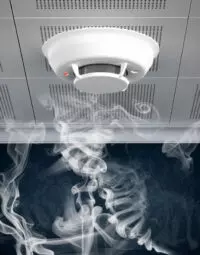
We understand the critical importance of procuring quality materials for the construction of reliable fire alarm panels. High-grade materials are not only essential for durability but also for the overall safety and effectiveness of the fire alarm system. Ensuring that each component, from the casing to the electronic circuits, meets stringent quality standards is a cornerstone of our commitment to safety.
The selection of materials directly influences the longevity and reliability of fire alarm panels. To illustrate, here’s a list of key materials and components we prioritise for their proven performance:
- Fire-resistant casing materials
- High-quality electronic components
- Durable mounting hardware
- Advanced communication modules
By choosing superior materials, we not only maintain safety regulations but also provide our customers with the assurance that their fire protection systems are built to last.
It is also vital to partner with reputable manufacturers who share our dedication to excellence. For instance, the Fire Panel Buying Guide from ADI Global offers insights into various types of fire panels and accessories, helping us make informed decisions. Our procurement process is rigorous, ensuring that every product we select is capable of withstanding the demands of its environment and providing dependable performance when it matters most.
Implementing the Right Fire Alarm Panel for You
Understanding and implementing the right fire alarm panels for your property is a critical component of ensuring safety in any building. From adhering to the Essential Principles of fire safety, such as maximising non-combustibility and anticipating arson attempts, to selecting quality materials and competent workmanship, every aspect plays a vital role in fire prevention and management. The importance of proper placement, regular maintenance, and understanding the different types of fire alarm systems cannot be overstated. Moreover, considering enhanced compartmentation and fire resistance can significantly improve the effectiveness of fire safety measures. As we have explored throughout this guide, taking a comprehensive and informed approach to fire alarm panels will not only comply with stringent safety regulations but will also safeguard lives and property against the devastating impact of fires.
Frequently Asked Questions
What are the key principles for fire alarm panels in the UK?
Key principles include maximising non-combustibility (Principle D), anticipating arson attempts (Principle E), monitoring building services (Principle F), extending structural stability (Principle H), reducing fire severity (Principle I), resisting fire ingress (Principle L), and minimising consequential damage (Principle N).
How should fire alarms be placed for maximum effectiveness?
Your commercial fire alarms should be installed in key locations to maximise their effectiveness, including smoke, heat, and carbon monoxide alarms. Placement should be strategic, considering the layout of the building and the presence of potential fire hazards.
What is an EICR and why is it important?
An Electrical Installation Condition Report (EICR) is a document that assesses the safety and reliability of electrical installations within a property. It is crucial for identifying defects or potential dangers that could lead to fires or other electrical hazards.
What different types of fire alarm systems are available in London?
London offers various types of fire alarm systems including conventional, addressable, wireless, and aspirating systems. Each type has its own applications and benefits, and the choice depends on the specific needs and regulations of the premises.
How does integrating fire alarm systems with fire escape routes enhance safety?
Integrating fire alarm systems with fire escape routes ensures that occupants are promptly alerted and can evacuate safely in the event of a fire. It also helps in managing the flow of people during an evacuation and reduces the risk of injury or entrapment.
What are the best practices for managing fire alarm panels?
Best practices include procuring quality materials (Principle T), verifying recorded information for accountability (Principle V), and upholding maintenance commitments to ensure ongoing safety and compliance with UK fire regulations (Principle Y).


